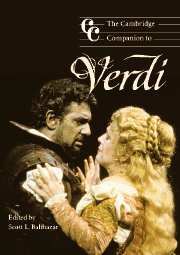Book contents
- Frontmatter
- Part I Personal, cultural, and political context
- Part II The style of Verdi's operas and non-operatic works
- 4 The forms of set pieces
- 5 Newcurrents in the libretto
- 6 Words and music
- 7 French influences
- 8 Structural coherence
- 9 Instrumental music in Verdi's operas
- 10 Verdi's non-operatic works
- Part III Representative operas
- Part IV Creation and critical reception
- Notes
- List of Verdi's works
- Select bibliography and works cited
- Index
6 - Words and music
from Part II - The style of Verdi's operas and non-operatic works
Published online by Cambridge University Press: 28 September 2011
- Frontmatter
- Part I Personal, cultural, and political context
- Part II The style of Verdi's operas and non-operatic works
- 4 The forms of set pieces
- 5 Newcurrents in the libretto
- 6 Words and music
- 7 French influences
- 8 Structural coherence
- 9 Instrumental music in Verdi's operas
- 10 Verdi's non-operatic works
- Part III Representative operas
- Part IV Creation and critical reception
- Notes
- List of Verdi's works
- Select bibliography and works cited
- Index
Summary
In Verdi's operas words are set to music in order to produce drama, to establish communication between the stage and the audience. Words and music are never entirely separate or completely independent domains, and therefore can never be fully understood in isolation. This aesthetic principle and its interpretive corollary have not always been obvious to Verdians, but now seem to be accepted by most. However, as soon as attention turns to the ways in which the aesthetic principle has been translated into practice, which involves applying the hermeneutic corollary to concrete examples, matters become more complex. There is no simple answer to the question of how drama is produced in Verdi's operas. Communication between the stage and the audience can be established at any given moment in many different ways. Moreover, both the concept and the practice of drama evolve through time. This means not only that Verdi's ideas on how communication might be established changed during his very long compositional career, but also that our ideas of drama might be significantly different from Verdi's and from those of his original audiences.
The paths to drama in Verdi's operas are not infinite, however, since interaction of words and music is always filtered through a set of conventions. Far from being a constricting presence – and notwithstanding what Verdi might have said about the matter in his letters – conventions make theatrical communication possible, and dialectic engagement with them seems to have been the composer's attitude through most of his career. Much of this chapter will therefore be devoted to operatic conventions that impinge on the relationship between words and music. I have decided to concentrate on three areas that best demonstrate Verdian conventions and their evolution: the interaction between text and music within the movements that constitute an operatic number; the so-called “parola scenica” and other moments of especially important communicative significance; and word painting.
- Type
- Chapter
- Information
- The Cambridge Companion to Verdi , pp. 88 - 110Publisher: Cambridge University PressPrint publication year: 2004
- 2
- Cited by



